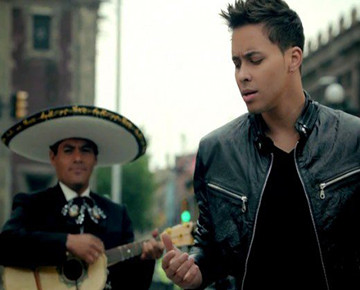
The frontier bachateros, with Antony Santos at their head, continued to enjoy success throughout the 1990s, and bachata continued to become both simpler and more romantic than it had been previously. The music’s audience grew as well, and with each step towards a larger market the genre moved away from the cabaret and doble sentido styles which had been so important in consolidating it. It was probably with Teodoro Reyes’ album, “El Cieguito Sabio”, in 1992, that the Dominican middle class began to accept genuine (as opposed to “tecno-“) bachata as its own, both in the Dominican Republic and in New York. Reyes had been singing and composing bachata for many years, and had written some of the most brazen doble sentido songs ever recorded. The songs in “El Cieguito Sabio”, however, while certainly cabaret bachata in many cases, were romantic enough and melodic enough to touch a nerve in segments of society which had never before been willing to accept bachata. The style of the arrangements, too, continued the process of simplification which had begun with Blas Durán and continued through Antony Santos, Luis Vargas and Raulín Rodriguez. During the 1970s, the lead guitar in arrangements by Edilio Paredes and Augusto Santos had been busy answering the singer, echoing the singer, and indicating harmonic changes; Reyes’ arrangements were among the first to contain a simple, rhythmic arpeggio pattern while the singer was singing, a pattern which remains standard in bachata to this day. The requinto had become a percussion instrument.
In the middle of the 1990s bachata took another turn towards romanticism with the rise of Joe Veras. Veras sang in a soft voice which contrasted with the traditional, almost mournful style of singing bachata which had been popularized by Luis Segura. Veras is the author of the majority of his songs. His lyrics, while displaying the street savvy which bachateros had always laid claim to, were more carefully constructed and showed a more middle-class aesthetic. Veras’ style of playing the guitar also differed considerably from the frontier bachateros’ style, and in his third production his recording of Camilo Sesto’s “Necesito saber” demonstrated the importance of balada to Veras’ work.
With the influence of bachateros like Veras, bachata had become essentially a romantic music by the end of the 1990s. Many bachateros’ songs deal with one theme and one theme only—love, often unrequited. Two of the most successful interpreters of this style of bachata have been Frank Reyes and Zacarias Ferreira. Reyes has even recorded some of his songs as baladas, as have Antony Santosand Raulín Rodriguez, further obscuring the differences between the two genres. Bachata’s audience, however, continues to resist a direct fusion of bachata with balada, as evidenced by the extremely disappointing performance of Ferreira’s “Adios”, an album in which he attempted to dress bachata up with traditional balada adornments like a synthesized string section.
que feo me da asco tu music
y se mucho bailar bachata soy um papa bailando ese ritmo y soy interprete del mismo
la bachata es un descanso para el alma donde se espresan los mas profundos sentimientos de un ser,soy bachatero romantico,dios vendiga hoy y siempre la bachata
Hola a todos. Para dar un poquito mas de informacion acerca de la historia del Vallenato y contibuyendo al comentario exquisito del comentarista LUIS del Aug-9-09, para el buen amante del vallenato o de cualquier otro genero musical, se tienen que informar e instruirse de la misma manera. La musica Vallenata nece hace mas de 70 años en el Valle De Upar hoy Valledupar. El nombre Vallenato viene de la conjugacion de dos palabras, Valle y Nato. Valle por Valle De Upar y Nato de nacido u original. Fue el temple de un pueblo amante a los sonidos del acordion caja y guacharaca que nacio el vallenato con sus cuatro aires previamente comentados por mi compadre Luis. Ya teniendo esta aclaracion y del tiempo desde su inicio de la musica Vallenata, no hay duda absoluta que otras regiones como la Republica Dominicana haya querido copiar, si asi pudiera decirlo, nuestra musica Vallenata. Por ejemplo... A lo que los Dominicanos llaman Merengue, ese ritmo salio del Vallenato, del Merengue Vallenato. A los que los Dominicanos llaman Perico Ripiao, ese ritmo salio de la Puya Vallenata. De lo que los Dominicanos llaman Bachata, salio del Paseo Vallenato. Todo esto TENIENDO EN CUENTA que para que haya una variacion en ritmos... los musicos Dominicanos le añaden diversos instrumentos musicales. Hoy por hoy el 80 porciento de las letras de Bachatas vienen del Vallenato Todo lo previamente dicho es producto de averiguaciones, estudios, historia. Antes de alguna respuesta o comentario obseno, le invito a que se instruyan y dejen de hacer alarde de lo que no es original. Pero como dice el dicho "LA VERDAD DUELE"
iva bachata cn b aprende
soy bachatera!!me encanta la bachata bailarla k os enseño jeje aventura arriba cris_monty5@hotmail.com
soy bachatera!!me encanta la bachata bailarla k os enseño jeje aventura arriba cris_monty5@hotmail.com
uuuuuuuuuuuuu laq mejor vachata la toca aventura atte ivan de tuxpan
raulin rodrigue
ven y unete al club de fans de los bachateros
Add new comment